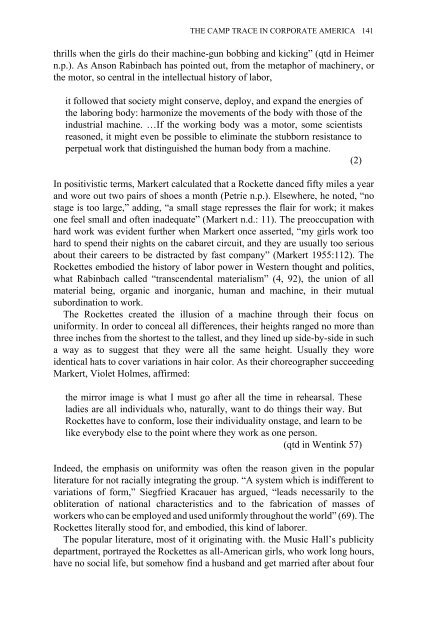Edited by Moe Meyer - Get a Free Blog
Edited by Moe Meyer - Get a Free Blog
Edited by Moe Meyer - Get a Free Blog
Create successful ePaper yourself
Turn your PDF publications into a flip-book with our unique Google optimized e-Paper software.
THE CAMP TRACE IN CORPORATE AMERICA 141<br />
thrills when the girls do their machine-gun bobbing and kicking” (qtd in Heimer<br />
n.p.). As Anson Rabinbach has pointed out, from the metaphor of machinery, or<br />
the motor, so central in the intellectual history of labor,<br />
it followed that society might conserve, deploy, and expand the energies of<br />
the laboring body: harmonize the movements of the body with those of the<br />
industrial machine. …If the working body was a motor, some scientists<br />
reasoned, it might even be possible to eliminate the stubborn resistance to<br />
perpetual work that distinguished the human body from a machine.<br />
(2)<br />
In positivistic terms, Markert calculated that a Rockette danced fifty miles a year<br />
and wore out two pairs of shoes a month (Petrie n.p.). Elsewhere, he noted, “no<br />
stage is too large,” adding, “a small stage represses the flair for work; it makes<br />
one feel small and often inadequate” (Markert n.d.: 11). The preoccupation with<br />
hard work was evident further when Markert once asserted, “my girls work too<br />
hard to spend their nights on the cabaret circuit, and they are usually too serious<br />
about their careers to be distracted <strong>by</strong> fast company” (Markert 1955:112). The<br />
Rockettes embodied the history of labor power in Western thought and politics,<br />
what Rabinbach called “transcendental materialism” (4, 92), the union of all<br />
material being, organic and inorganic, human and machine, in their mutual<br />
subordination to work.<br />
The Rockettes created the illusion of a machine through their focus on<br />
uniformity. In order to conceal all differences, their heights ranged no more than<br />
three inches from the shortest to the tallest, and they lined up side-<strong>by</strong>-side in such<br />
a way as to suggest that they were all the same height. Usually they wore<br />
identical hats to cover variations in hair color. As their choreographer succeeding<br />
Markert, Violet Holmes, affirmed:<br />
the mirror image is what I must go after all the time in rehearsal. These<br />
ladies are all individuals who, naturally, want to do things their way. But<br />
Rockettes have to conform, lose their individuality onstage, and learn to be<br />
like everybody else to the point where they work as one person.<br />
(qtd in Wentink 57)<br />
Indeed, the emphasis on uniformity was often the reason given in the popular<br />
literature for not racially integrating the group. “A system which is indifferent to<br />
variations of form,” Siegfried Kracauer has argued, “leads necessarily to the<br />
obliteration of national characteristics and to the fabrication of masses of<br />
workers who can be employed and used uniformly throughout the world” (69). The<br />
Rockettes literally stood for, and embodied, this kind of laborer.<br />
The popular literature, most of it originating with. the Music Hall’s publicity<br />
department, portrayed the Rockettes as all-American girls, who work long hours,<br />
have no social life, but somehow find a husband and get married after about four


